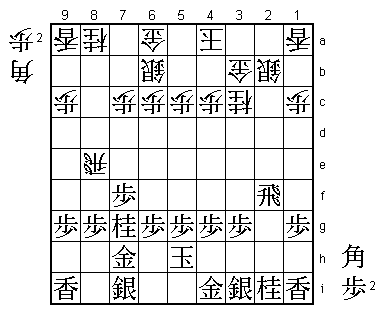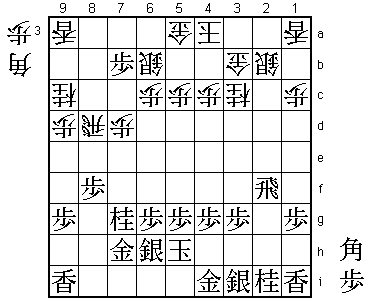68th Meijin Match Game 1
[Black "Miura Hiroyuki, Challenger"]
[White "Habu Yoshiharu, Meijin"]
[Event "68th Meijin-sen, Game 1"]
[Date "April 8th and 9th 2010"]
1.P2g-2f 00:00:00 00:00:00
The first furigoma before the start of this Meijin match ended in a tie, with two
tokins and two pawns showing, while the fifth piece stood on its side. The second
furigoma showed three tokins, so challenger Miura started the match with the black
pieces.
2.P3c-3d 00:00:00 00:01:00
3.P7g-7f 00:01:00 00:01:00
4.P8c-8d 00:01:00 00:03:00
5.P2f-2e 00:06:00 00:03:00
6.P8d-8e 00:06:00 00:07:00
7.G6i-7h 00:09:00 00:07:00
8.G4a-3b 00:09:00 00:11:00
9.P2e-2d 00:11:00 00:11:00
10.P2cx2d 00:11:00 00:13:00
11.R2hx2d 00:11:00 00:13:00
12.P8e-8f 00:11:00 00:18:00
13.P8gx8f 00:11:00 00:18:00
14.R8bx8f 00:11:00 00:18:00
15.R2dx3d 00:12:00 00:18:00
16.B2b-3c 00:12:00 00:26:00
17.R3d-3f 00:30:00 00:26:00
18.S3a-2b 00:30:00 00:34:00
19.K5i-5h 00:42:00 00:34:00
20.K5a-4a 00:42:00 00:56:00
21.P*8g 01:16:00 00:56:00
22.R8f-8e 01:16:00 01:03:00
The R8e Yokofudori is not as popular anymore as it was a couple of years ago, but
there is still a lot of unknown territory to exploit. Actually, the last game Habu
and Miura played before the Meijin match, an Oi league game in February, was played
with this same opening (also with Miura being black).
23.R3f-2f 01:20:00 01:03:00
24.S7a-6b 01:20:00 01:30:00
25.B8hx3c+ 01:22:00 01:30:00
26.N2ax3c 01:22:00 01:37:00
27.N8i-7g 01:23:00 01:37:00

The timing of this knight attack has been the topic of an interesting theoretical
debate. The sharper alternative is to play this knight before moving the rook to 2f
(i.e. exchange bishops on the 23rd move or earlier and then play N7g on move 25).
This gives white the option of playing R2e, which in turn forces black to drop a
pawn on the second file with P*2f and play continues with R2d G3h G7b and the white
gold is taking over the defense of the 8th file from the rook. This has been played
regularly since 2003 (the most famous recent example is the 7th game of the Oi match
between Fukaura and Kimura in September last year) and even though the black winning
percentage is high, the general opinion is that the chances are pretty even. A much
older way of playing is to play the gold to 3h instead of the rook to 2f and then
play N7g. This takes away the option of R2e because after P*2f R2d black can drop
the bishop on 8b for free. Therefore, white has to retreat with R8d after which black
can try to put pressure on the rook with P7e and P8f followed by P8e. However, in
this variation, white can switch the rook to 2d at some point, forcing black to defend
the second file with a pawn drop. This loss of a move (G3h) and a pawn in hand is the
reason that this way of playing has almost completely disappeared from professional
play. The way Miura plays N7g in this game combines the best of both of these earlier
plans. White cannot switch the rook to the second file and black doesn't need the gold
or a pawn to defend against a rook switch. Therefore, white only has R8d here, after
which black threatens to put pressure on the rook with P7e and P8f followed by P8e.
28.R8e-8d 01:23:00 01:56:00
29.P7f-7e 01:31:00 01:56:00
30.G6a-5a 01:31:00 02:17:00
31.S7i-6h 01:37:00 02:17:00
32.P9c-9d 01:37:00 02:35:00
This is a vital move for white because the knight needs to go to 9c to prevent the
earlier mentioned attack of P8f followed by P8e. The problem is that this creates
a potential problem on 9d where the head of the white knight is a weakness. It seems
like this is an important advantage for black, but at the moment there is no conclusion
about who has the better chances in this position.
33.P8g-8f 01:38:00 02:35:00
34.N8a-9c 01:38:00 02:46:00
35.P7e-7d 01:39:00 02:46:00
36.P7cx7d 01:39:00 02:53:00
37.P*7b 01:44:00 02:53:00

38.R8d-8a 01:44:00 03:00:00
Habu is the first to change the moves from the game played in the Oi league. There it
followed 38.B*4d R5f P*2f P*2h and even though Habu won that game, the bishop on 4d
became a liability and he had to work very hard to stay in the game.
39.P9g-9f 02:05:00 03:00:00
This is why nobody had tried 38.R8a before. The head of the knight is now very
vulnerable to an edge attack.
40.P7d-7e 02:05:00 03:16:00
This is Habu's real plan. He has seen that he can also attack the head of the knight
and that it is not so clear which knight is weaker.
41.P7b-7a+ 02:54:00 03:16:00
42.R8ax7a 02:54:00 04:18:00
43.B*8b 02:58:00 04:18:00

44.R7a-8a 02:58:00 05:14:00
The sealed move and a surprise, because this seems to be bad after making a promoted
bishop with 45.B5e+, because even though white can exchange this bishop with 46.B*4d,
this is good for black after +Bx4d Px4d P*7c! and Sx7c fails to B*7b while R8b gives
black a strong edge attack after P9e. Therefore, everyone expected Habu to play
45.R7d rather quickly, to start a mutual attack after 45.Bx9a+ 46.P7f. Then 47.N6e
is answered by B*4d and 47.+B9b by Px7g+ Sx7g R5d +Bx9c N4e which seems to give white
chances as well. An interesting side note here was that because Habu spent 56 minutes
to think about this move, Miura didn't get the chance to seal the move for the first
time in his professional career. Miura has appeared in a number of title matches
(winning the Kisei title in 1996), but all of these were matches where the game took
only one day. It seems that he actually practiced how to seal a move before this
match started, but he will have to wait at least one more game before he can use
what he learned.
45.B8b-5e+ 03:01:00 05:14:00
46.B*7f! 03:01:00 05:16:00
This move requires a lot of flexibility in thinking about the position, which has
been one of the things that Habu excels in. Only a few professionals would even
consider this move because it voluntarily blocks the pawn on the 7th file, which
had been the key to white's counter attack up until this point. The second surprising
thing about 46.B*7f is that it threatens the quite simple Rx8f followed by Bx6g+
picking off the rook, but this threat is very hard to defend against.
47.P*7c 05:12:00 05:16:00
Habu was more than two hours behind on the clock after 46.B*7f, but Miura evened
this in one move by taking 131 minutes before playing P*7c, admitting that he had
completely overlooked 46.B*7f.
48.R8ax8f 05:12:00 06:32:00
49.P7c-7b+ 05:27:00 06:32:00
50.B7fx6g+ 05:27:00 06:33:00
51.S6hx6g 06:52:00 06:33:00
52.R8fx2f 06:52:00 06:34:00
Black has made a tokin on 7b, which is very strong, but white has taken the time
to make this tokin to move the rook to the other side of the board, taking a second
rook at the same time. Although Habu succeeded in rattling Miura a little, the chances
still seem to be pretty even here.
53.N7g-6e 06:57:00 06:34:00

54.R2f-2e!? 06:57:00 07:00:00
Another Habu curveball. The obvious move is 54.Rx2i+, but Habu felt that he would
lose after 55.B*8d next. In fact, this seems far from clear-cut. For example, 56.N*2g
S3h R*2h and even though black picks up all the white pieces after +Px6b N3i+ +P5i
the white king has a lot of space to run (going as far as 2a) and will not be easy
to catch.
55.+B5ex9a 07:34:00 07:00:00
56.R2ex6e 07:34:00 07:01:00
57.+P7bx6b 07:41:00 07:01:00
58.G5ax6b 07:41:00 07:01:00
59.B*7a 07:42:00 07:01:00
White has taken the important attacking knight on 6e, but it seems that black has
not only managed to get a material advantage, the black attack also seems to be faster.
The general opinion in the press room was that black had the advantage here. In
reality, things are not at all clear at this point.
60.G6b-5b 07:42:00 07:46:00
61.L*6f 08:01:00 07:46:00
62.R6e-2e 08:01:00 07:58:00
63.+B9a-7c 08:01:00 07:58:00
64.G5b-4b 08:01:00 07:59:00
65.L6fx6c+ 08:13:00 07:59:00
66.P*6f 08:13:00 08:10:00
67.S6gx6f 08:13:00 08:10:00
68.N*5d 08:13:00 08:14:00
69.P*6g 08:19:00 08:14:00
70.R*8i 08:19:00 08:17:00
71.+L6cx5c 08:43:00 08:17:00
72.R2ex2i+ 08:43:00 08:25:00
73.S*5a 08:54:00 08:25:00
74.P*3h! 08:54:00 08:42:00

There is a little trap here, because if black takes this pawn immediately with
74.Sx3h, he is mated after 75.+Rx3h Gx3h S*4i K6h N*7f K7g N8e. If this trap was
the main idea behind this move, it would just be desperation, but there is a much
more subtle meaning.
75.+B7c-6c 08:54:00 08:42:00
This seems like the perfect reply, because this promoted bishop now defends the
square 8e, so the white mate no longer works. However, forcing the silver to 3h
has a long term merit, while forcing the promoted bishop to 6c allows a different
attack.
76.P*5b 08:54:00 08:42:00
77.S3ix3h 08:54:00 08:42:00
78.N*4f 08:54:00 08:47:00
79.P4gx4f 08:54:00 08:47:00
80.N5dx4f 08:54:00 08:47:00
This would not have been possible with the promoted bishop still on 7c. Also,
because there is a silver on 3h, this is now attacked by the knight on 4f. All
made possible by the powerful pawn drop 74.P*3h. A nice piece of Habu endgame
magic.
81.K5h-4g 08:54:00 08:47:00
82.N4fx3h+ 08:54:00 08:47:00

83.N*3d? 08:58:00 08:47:00
Even though Habu seems to have turned the position in his favor, Miura is throwing
the towel too easily here. Things would also have been good for white after 83.K5f
Kx5a N*3d S*4e K6e Sx3d, but it seems that the best fighting chance was 83.+Lx4b
Gx4b Sx4b+ and after the long variation Kx4b N*3d K3b G*4b K2c Nx2b+ Kx2b P*2c Kx2b
S*3b K1b G*2c +Rx2c Sx2c+ Kx2c P*2d Kx2d and black has to give white the initiative
back which he can use for a move like N*4d. The position still seems very difficult,
but in the post-mortem analysis no winning variation for black was found, so maybe
white still has the edge even if black plays 83.+Lx4b. In any case, this would have
been Miura's best chance to make it difficult for Habu.
84.+R2ix4i 08:58:00 08:48:00
85.K4g-5f 08:58:00 08:48:00
86.S*4e 08:58:00 08:48:00
The point. White simply takes the knight on 3d, slowing the black attack long enough
to set up a mating attack.
87.K5f-6e 08:58:00 08:48:00
88.S4ex3d 08:58:00 08:48:00
89.P*2c 08:58:00 08:48:00
90.P*6d 08:58:00 08:53:00
91.K6ex7e 08:58:00 08:53:00
92.R8i-8c+ 08:58:00 08:53:00
93.+L5cx4b 08:59:00 08:53:00
94.G3bx4b 08:59:00 08:53:00
95.B7a-6b+ 08:59:00 08:53:00
96.P*7d 08:59:00 08:55:00
97.+B6cx7d 08:59:00 08:55:00
98.G*7f 08:59:00 08:56:00
99.K7ex7f 08:59:00 08:56:00
100.+R8cx7d 08:59:00 08:56:00
101.G*7e 08:59:00 08:56:00
102.B*5d 08:59:00 08:56:00
Resigns 08:59:00 08:56:00

Mate after 103.K7g +Rx7e etc., 103.K8f L*8e etc. or 103.G*6e Bx6e Sx6e G*8e K8g
L*8f etc. so Miura resigned here. It seems like Miura had some chances in this
game to put a little bit of pressure on Habu, who recently lost the Osho title
to Kubu, which may have put a little dent in his confidence. Instead, Habu uses a
little of his magic dust to take the game with the white pieces, which is a great
way to start a title defense. Can Miura come back in the second game to even
the match?






